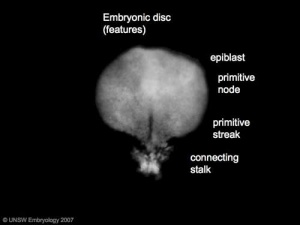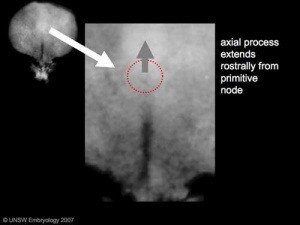2009 Lecture 4: Difference between revisions
| Line 48: | Line 48: | ||
* '''Week 3 Slides''' [http://embryology.med.unsw.edu.au/Science/ANAT2341lecture04.htm Lecture 4 2008] | [http://embryology.med.unsw.edu.au/pdf/ANAT2341L3Week1s1.pdf Lecture 4 2008 slides] | * '''Week 3 Slides''' [http://embryology.med.unsw.edu.au/Science/ANAT2341lecture04.htm Lecture 4 2008] | [http://embryology.med.unsw.edu.au/pdf/ANAT2341L3Week1s1.pdf Lecture 4 2008 slides] | ||
* '''Week 3 Movies''' [http://embryology.med.unsw.edu.au/Movies/week2/chorcav.mov Chorionic cavity] [http://embryology.med.unsw.edu.au/Movies/larsen/notoch.mov Movie - notochord 1] | [http://embryology.med.unsw.edu.au/Movies/larsen/noto.movMovie - notochord 2] | [http://embryology.med.unsw.edu.au/Movies/week2/exoves.mov Extracoelomic cavity] | [http://embryology.med.unsw.edu.au/Movies/week3/week3NodeCilia.htm Nodal Cilia Movement] | * '''Week 3 Movies''' [http://embryology.med.unsw.edu.au/Movies/week2/chorcav.mov Chorionic cavity] [http://embryology.med.unsw.edu.au/Movies/larsen/notoch.mov Movie - notochord 1] | [http://embryology.med.unsw.edu.au/Movies/larsen/noto.movMovie - notochord 2] | [http://embryology.med.unsw.edu.au/Movies/week2/exoves.mov Extracoelomic cavity] | [http://embryology.med.unsw.edu.au/Movies/week3/week3NodeCilia.htm Nodal Cilia Movement] | ||
* '''Week 3 Notes''' [http://embryology.med.unsw.edu.au/Notes/week3.htm Week 3] | [http://embryology.med.unsw.edu.au/Notes/week3_3.htm Gastrulation] | [http://embryology.med.unsw.edu.au/Notes/week3_4.htm Trilaminar Embryo] | [http://embryology.med.unsw.edu.au/Notes/week3_5.htm Neural Tube Formation] | [http://embryology.med.unsw.edu.au/Notes/week3_6.htm Early Somite Formation] | [http://embryology.med.unsw.edu.au/Notes/mechanism.htm Developmental Mechanisms] | [http://embryology.med.unsw.edu.au/Notes/mechanism1.htm Epithelial Mesenchymal Transition] | [http://embryology.med.unsw.edu.au | * '''Week 3 Notes''' [http://embryology.med.unsw.edu.au/Notes/week3.htm Week 3] | [http://embryology.med.unsw.edu.au/Notes/week3_3.htm Gastrulation] | [http://embryology.med.unsw.edu.au/Notes/week3_4.htm Trilaminar Embryo] | [http://embryology.med.unsw.edu.au/Notes/week3_5.htm Neural Tube Formation] | [http://embryology.med.unsw.edu.au/Notes/week3_6.htm Early Somite Formation] | [http://embryology.med.unsw.edu.au/Notes/mechanism.htm Developmental Mechanisms] | [http://embryology.med.unsw.edu.au/Notes/mechanism1.htm Epithelial Mesenchymal Transition] | [http://embryology.med.unsw.edu.au/MolDev/MolDev.htm Molecular Development] | [http://embryology.med.unsw.edu.au/Notes/week3_2.htm Abnormalities] | | ||
== Glossary Links == | == Glossary Links == | ||
Revision as of 15:28, 3 August 2009
Week 3 Development
Introduction
This lecture will continue from the second week into the third week and discuss early placentation and gastrulation. Note that we will be covering only the early events of placentation and a later lecture will cover this topic in more detail.
- Lectopia Lecture Audio
Lecture Overview
- Understand broadly the events of week 2-3 of human development
- Understand the process early placentation, villi formation
- Understand the process of gastrulation
- Understand the process of axis formation
Early Placentation
Syncitiotrophoblasts - invading the decidua and secreting hCG Cytotrophoblasts - form a cellular layer around the blastocyst, proliferates and extends behind syncitiotrophoblasts
Early Utero-Placental exchange - transfer of nutrition from maternal lacunae filled with secretions from uterine glands and maternal blood from blood vessels. The development of trophoblast villi extending into the uterine decidua.
There are three stages of villi development:
- Primary Villi - cytotrophoblast
- Secondary Villi - cytotrophoblast + extraembryonic mesoderm
- Tertiary Villi - cytotrophoblast + extraembryonic mesoderm+ blood vessels
There are two main types of early villi:
- Anchoring villi - attached to decidua
- Floating villi - not attached to decidua, floating in maternal lacunae.
Gastrulation
Gastrulation, (Greek = belly) means the formation of gut, but has been used in a more looser sense to to describe the formation of the trilaminar embryo. The epiblast layer, consisting of totipotential cells, derives all 3 embryo layers: endoderm, mesoderm and ectoderm. The primitive streak is the visible feature which represents the site of cell migration to form the additional layers.
Historically, gastrulation was one of the earliest observable morphological event occurring in the frog embryo. Currently, the molecular and physical mechanisms that regulate patterning and migration during this key event are being investigated in several different animal models. In humans, it is proposed that similar mechanisms regulate gastrulation to those found in other vertebrates.
Notochord
Movie - notochord 1 | - notochord 2
The notochord is a structure which has an early mechanical role in embryonic disc folding and a major signaling role in patterning surrounding embryonic tissue development. This signaling role patterns many different tissues (neural plate, neural tube, somites, endodermal organs). It has its own sequence of development from a primitive axial process and is a developmental feature not present in the adult anatomy.
- axial process an initial epiblast hollow epithelial tube which extends in the midline from the primitive pit, cranially in the embryonic disc (toward the oral membrane).
- neuroenteric canal is a transient communication between the amnionic cavity and the yolk sac cavity formed by the axial process.
- notochordal plate forms from the axial process merging with the endoderm layer.
- notochord forms from the notochordal plate which then separates back into the mesoderm layer as a solid column of cells lying in the midline of the embryonic disc and running rostro-caudally (head to tail).
MH - Much of our knowledge of this structure comes from the study of animal models of development.
UNSW Embryology Links
- Week 3 Slides Lecture 4 2008 | Lecture 4 2008 slides
- Week 3 Movies Chorionic cavity Movie - notochord 1 | - notochord 2 | Extracoelomic cavity | Nodal Cilia Movement
- Week 3 Notes Week 3 | Gastrulation | Trilaminar Embryo | Neural Tube Formation | Early Somite Formation | Developmental Mechanisms | Epithelial Mesenchymal Transition | Molecular Development | Abnormalities |
Glossary Links
A | B | C | D | E | F | G | H | I | J | K | L | M | N | O | P | Q | R | S | T | U | V | W | X | Y | Z
References
Textbooks
- The Developing Human: Clinically Oriented Embryology (8th Edition) by Keith L. Moore and T.V.N Persaud - Chapter 3
- Larsen’s Human Embryology by GC. Schoenwolf, SB. Bleyl, PR. Brauer and PH. Francis-West - Chapter 3
Online Textbooks
- Developmental Biology by Gilbert, Scott F. Sunderland (MA): Sinauer Associates, Inc.; c2000 Figure 11.22. The cleavage of a single mouse embryo in vitro | Figure 11.25. Mouse blastocyst hatching from the zona pellucida | Figure 11.20. Development of a human embryo from fertilization to implantation | Figure 11.24. Implantation of the mammalian blastocyst into the uterus
- Molecular Biology of the Cell 4th ed. Alberts, Bruce; Johnson, Alexander; Lewis, Julian; Raff, Martin; Roberts, Keith; Walter, Peter New York and London: Garland Science; c2002 - Fertilization | Figure 21-84. Scanning electron micrographs of the early mouse embryo | Figure 21-69. The blastula
- Molecular Cell Biology by Lodish, Harvey; Berk, Arnold; Zipursky, S. Lawrence; Matsudaira, Paul; Baltimore, David; Darnell, James E. New York: W. H. Freeman & Co.; c1999 Chapter 13. Regulation of the Eukaryotic Cell Cycle
- The Cell - A Molecular Approach by Cooper, Geoffrey M. Sunderland (MA): Sinauer Associates, Inc.; c2000 Figure 14.37. Meiosis of vertebrate oocytes
- HSTAT - In Vitro Fertilization As A Medical Treatment For Male or Female Infertility
- Human Molecular Genetics 2 Strachan, Tom and Read, Andrew P. New York and London: Garland Science; c1999 Figure 8.19. Changes in DNA methylation during mammalian development
Search
- Bookshelf blastocyst | morula | implantation | ectopic pregnancy
- Pubmed blastocyst | implantation | ectopic pregnancy |
Next Lecture
Lab 2 | Lecture 5 | Course Timetable
- Dr Mark Hill 2009 UNSW CRICOS Provider Code No. 00098G


